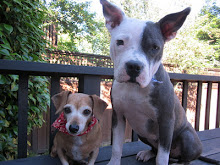If there was ever any doubt that three-legged dogs can lead active, fulfilling lives, this video of Serena the tripod should prove otherwise!
Serena is a regular agility competitor. Her human, Amy Breton, has great insights to share about caring for a tripod dog. Here is a blog post she wrote last summer:
Three-Legged Pets Are Amazing! (Rules To Keeping Your Disabled Pet Able)
Serena, my dog, only has three legs. She didn’t always have three legs; but one day cancer took one of her legs from her. After her surgery I pictured what every pet owner fears…that my best friend wouldn’t have as good of a life as she did when she was four-legged.
One month later, my tripod made her comeback in agility as a three-legged dog. She stole the show and proved to every four-legged dog that she was a force to be reckoned with. Three years later, she has one champion title and continues to earn points towards a second title.
If your pet just recently experienced an amputation, or if you are facing such a decision right now, you should know that having a pet with three legs doesn’t mean they will have a poor quality of life. From my own experience, the human has a harder time with the amputation then the pet.
Most diseases or injuries that require a pet to have a leg amputation are painful. By removing the painful limb, the animal can start to heal. Most pets will be up and walking on three legs about 8-12 hours after surgery. Although I work in a veterinary clinic and have dealt with many amputees, the initial shock of seeing my own dog as a three-legged dog is something I will never forget. Once Serena was fully recovered from surgery, I followed some simple steps to ensure that she would be as happy as any “normal-abled” pet.
1. Keep your tripod a healthy weight. This is one of the most important things you must do as an owner. If your tripod is overweight, even by a couple of pounds, it will mean more stress on the remaining three limbs. Many owners want to over-indulge their tripods with food because they feel bad for them, but don’t forget your tripod thinks having three legs is normal! Obesity is a serious problem for many four-legged pets, but it is even a bigger problem if they have three legs.
How do you know if your pet is overweight and what can you do about it? Check out these websites:
www.petobesityprevention.com
vetmedicine.about.com (search keyword: obesity)
www.peteducation.com (search keyword: obesity)
www.petplace.com (search keyword: obesity)
2. Once your tripod has recovered from surgery, start exercising! Be sure to talk to your veterinarian first to ask about what kind of physical activity and how much is appropriate for your pet. Tripods can still pounce, wrestle with their dog and cat friends and go for hikes in the woods. Too many owners think that their disabled pet isn’t allowed to exercise. This causes a decrease in muscle mass and makes it harder for these animals to get around.
3. Talk to your veterinarian about a formal physical therapy program. It’s important to build up muscle mass on the remaining three legs. If your dog was not an active dog prior to amputation, then it is very important that he becomes an active dog now. Physical therapy centers have trained individuals that use techniques and tools, such as underwater treadmills and exercise balls, to help keep your three-legged pet active.
4. Don’t overly baby your disabled pet. Immediately after surgery you can spoil your pet silly, but then you must take steps to make life as normal as it was prior to the amputation. Many owners will reinforce attention-seeking behaviors, causing the pet to act out for the owner’s attention. One example is a Labrador who, after an amputation, trained his owners to sleep on the floor with him. If they tried to sleep in a bed, he would start howling and crying until they came back to the floor. The owners had slept on an air mattress for over six months because they had overly spoiled their tripod!
5. Ask for help. Your pet isn’t the only tripod out there. It’s normal for your three-legged pet to be a little slower, but most everything they use to love doing they should be able to do. There are many joint supplements and pharmaceuticals available to help your pet be just as active as they were when they had four legs. Halo makes an all-natural hip and joint supplement that contains glucosamine and chondroitin, which builds collagen and helps maintain cartilage. If there’s something your pet use to enjoy, but seems to struggle with now, ask your veterinarian for advice. There are many support groups and tripod owners to help you!
It’s important to realize that an amputation doesn’t mean your pet will live a life of lying around doing nothing. On the contrary, most disabled pets go on to live very active lives. Just ask Faith. She is the famous two-legged dog that walks upright. Faith has led a very active life walking around on two legs. Check out her amazing pictures and video on her website:
www.faiththedog.net
For more information on amputations please check out:
www.petplace.com (search keyword: amputation)
Subscribe to:
Post Comments (Atom)




1 comment:
I have a tripod dog. He was in an accident, suffered a broken pelvis and had a front leg amputated. It has been 5 months now since his surgery, and he's running/jumping/playing JUST like before the accident.
It's true that it was beyond shocking to see my beloved pet with only three legs, but it never fazed him. He was up and walking just days after the surgery and amputation. He's living a completely normal life - walks every night, hangs out with his doggy friends, and snuggles on the couch.
Post a Comment